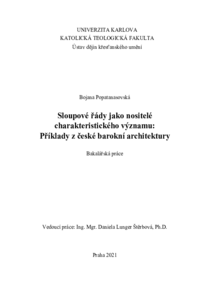Sloupové řády jako nositelé charakteristického významu: Příklady z české barokní architektury
Column orders as bearers of particular meaning: Examples from Czech Baroque architecture
bachelor thesis (DEFENDED)

View/
Permanent link
http://hdl.handle.net/20.500.11956/152614Identifiers
Study Information System: 235612
Collections
- Kvalifikační práce [2276]
Author
Advisor
Referee
Oulíková, Petra
Faculty / Institute
Catholic Theological Faculty
Discipline
History of Christian Arts
Department
Institute of Christian Art History
Date of defense
14. 9. 2021
Publisher
Univerzita Karlova, Katolická teologická fakultaLanguage
Czech
Grade
Excellent
Keywords (Czech)
barokní architektura, sloupové řády, symbolika, emblematika, Jan Blažej Santini-Aichel, Kilián Ignác DientzenhoferKeywords (English)
baroque architecture, column orders, symbolism, emblematics,Jan Blažej Santini-Aichel, Kilián Ignác DientzenhoferCílem této bakalářské práce je představit sloupové řády jako možné nositele určitého významu. Z toho důvodu byla zejména v barokním období pětice řádů různými způsoby modifikována. Nejběžnější z těchto modifikací ve své práci představím na několika příkladech rozdělených podle pětice známých sloupových řádů a jednoho novotvaru, jehož symbolický význam se pokusím lépe přiblížit. V případě řádu toskánského jde o příklad brány Císařského mlýna v Bubenči, úpravu řádu dórského pak demonstruji na příkladu symboliky kladí bočního průčelí kostela sv. Tomáše v Praze na Malé Straně. Řády jónský a korintský v jedné kapitole popíši na příkladu fasády trojského zámku v Praze a řád kompozitní na příkladu členění interiéru kostela sv. Jana Nepomuckého na Skalce. Poslední část práce se věnuje jistému novotvaru zavedených řádů, který se pokusím lépe přiblížit na souboru staveb v okolí cisterciáckého opatství v Plasích, konkrétně pak na samotném konventu plaského kláštera, kapli Jména Panny Marie v Mladoticích a poutním kostele Zvěstování Panny Marie v Mariánské Týnici.
Column orders as bearers of characteristic meaning: Examples from Czech Baroque Architecture The aim of this bachelor thesis is to present the column orders as possible bearers of a certain meaning. For this reason, especially in the Baroque period, the five orders were modified in various ways. In my thesis I will present the most common of these modifications by means of several examples divided according to the five known column orders and one new form whose symbolic meaning I will try to better approach. In the case of the Tuscan Order, this is the example of the gate of the Imperial Mill in Bubenč, while I will demonstrate the modification of the Doric Order by the example of the symbolism of the side facade of the Church of St. Thomas in Prague's Lesser Town. I will describe the Ionic and Corinthian orders in one chapter using the example of the facade of the Troja castle in Prague and the Composite order on the example of the interior of the church of St. John of Nepomuk in Skalka. The last part of the thesis is devoted to a certain new form of the established orders, which I will try to present better on a set of buildings in the surroundings of the Cistercian abbey in Plasy, specifically on the convent of the Plasy monastery itself, the chapel of the Name of the Virgin Mary in Mladotice...
